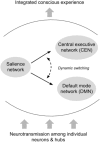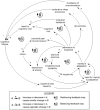The Dynamics of Concussion: Mapping Pathophysiology, Persistence, and Recovery With Causal-Loop Diagramming
- PMID: 29670568
- PMCID: PMC5893805
- DOI: 10.3389/fneur.2018.00203
The Dynamics of Concussion: Mapping Pathophysiology, Persistence, and Recovery With Causal-Loop Diagramming
Abstract
Despite increasing public awareness and a growing body of literature on the subject of concussion, or mild traumatic brain injury, an urgent need still exists for reliable diagnostic measures, clinical care guidelines, and effective treatments for the condition. Complexity and heterogeneity complicate research efforts and indicate the need for innovative approaches to synthesize current knowledge in order to improve clinical outcomes. Methods from the interdisciplinary field of systems science, including models of complex systems, have been increasingly applied to biomedical applications and show promise for generating insight for traumatic brain injury. The current study uses causal-loop diagramming to visualize relationships between factors influencing the pathophysiology and recovery trajectories of concussive injury, including persistence of symptoms and deficits. The primary output is a series of preliminary systems maps detailing feedback loops, intrinsic dynamics, exogenous drivers, and hubs across several scales, from micro-level cellular processes to social influences. Key system features, such as the role of specific restorative feedback processes and cross-scale connections, are examined and discussed in the context of recovery trajectories. This systems approach integrates research findings across disciplines and allows components to be considered in relation to larger system influences, which enables the identification of research gaps, supports classification efforts, and provides a framework for interdisciplinary collaboration and communication-all strides that would benefit diagnosis, prognosis, and treatment in the clinic.
Keywords: causal-loop diagram; complexity; concussion; models of injury; recovery; systems medicine; systems science; traumatic brain injury.
Figures









Similar articles
-
Concussion As a Multi-Scale Complex System: An Interdisciplinary Synthesis of Current Knowledge.Front Neurol. 2017 Sep 28;8:513. doi: 10.3389/fneur.2017.00513. eCollection 2017. Front Neurol. 2017. PMID: 29033888 Free PMC article. Review.
-
American Medical Society for Sports Medicine position statement: concussion in sport.Br J Sports Med. 2013 Jan;47(1):15-26. doi: 10.1136/bjsports-2012-091941. Br J Sports Med. 2013. PMID: 23243113 Review.
-
System dynamics modeling for traumatic brain injury: Mini-review of applications.Front Bioeng Biotechnol. 2022 Aug 12;10:854358. doi: 10.3389/fbioe.2022.854358. eCollection 2022. Front Bioeng Biotechnol. 2022. PMID: 36032727 Free PMC article. Review.
-
The future of Cochrane Neonatal.Early Hum Dev. 2020 Nov;150:105191. doi: 10.1016/j.earlhumdev.2020.105191. Epub 2020 Sep 12. Early Hum Dev. 2020. PMID: 33036834
-
Long drives and red tape: mapping rural veteran access to primary care using causal-loop diagramming.BMC Health Serv Res. 2022 Aug 23;22(1):1075. doi: 10.1186/s12913-022-08318-2. BMC Health Serv Res. 2022. PMID: 35999540 Free PMC article.
Cited by
-
Eye Movements in Mild Traumatic Brain Injury: Clinical Challenges.J Eye Mov Res. 2022 Jun 14;15(2):10.16910/jemr.15.2.3. doi: 10.16910/jemr.15.2.3. eCollection 2022. J Eye Mov Res. 2022. PMID: 36439910 Free PMC article.
-
Classification of Electroencephalogram in a Mouse Model of Traumatic Brain Injury Using Machine Learning Approaches.Annu Int Conf IEEE Eng Med Biol Soc. 2020 Jul;2020:3335-3338. doi: 10.1109/EMBC44109.2020.9175915. Annu Int Conf IEEE Eng Med Biol Soc. 2020. PMID: 33018718 Free PMC article.
-
Mild Traumatic Brain Injury/Concussion Initiates an Atypical Astrocyte Response Caused by Blood-Brain Barrier Dysfunction.J Neurotrauma. 2022 Jan;39(1-2):211-226. doi: 10.1089/neu.2021.0204. J Neurotrauma. 2022. PMID: 34806422 Free PMC article.
-
Oculomotor Deficits and Symptom Severity Are Associated With Poorer Dynamic Mobility in Chronic Mild Traumatic Brain Injury.Front Neurol. 2021 Jul 26;12:642457. doi: 10.3389/fneur.2021.642457. eCollection 2021. Front Neurol. 2021. PMID: 34381408 Free PMC article.
-
Towards the Development of a System Dynamics Model for the Prediction of Lower Extremity Injuries.Int J Exerc Sci. 2023 Aug 1;16(3):1052-1065. doi: 10.70252/OJBI8280. eCollection 2023. Int J Exerc Sci. 2023. PMID: 37649464 Free PMC article. Review.
References
-
- Raskin SA, Lovejoy DW, Stevens MC, Zamroziewicz M, Oakes HJ. Mild traumatic brain injury. In: Levin HS, Shum DHK, Chan RCK, editors. Understanding Traumatic Brain Injury: Current Research and Future Directions. New York: Oxford University Press; (2014). p. 370–412.
Grants and funding
LinkOut - more resources
Full Text Sources
Other Literature Sources
Medical

